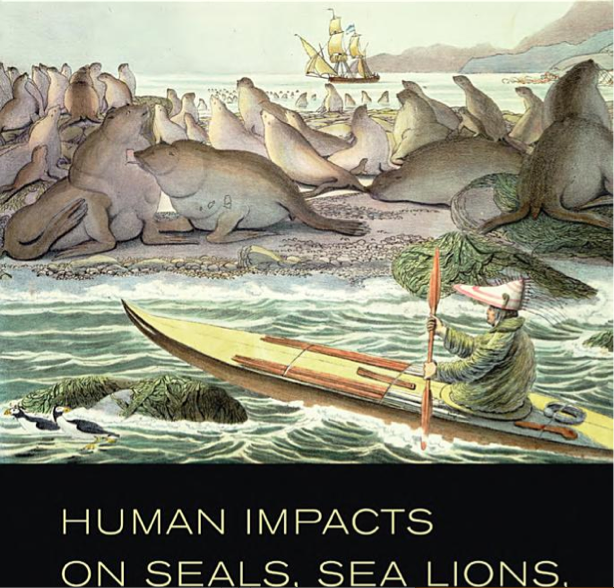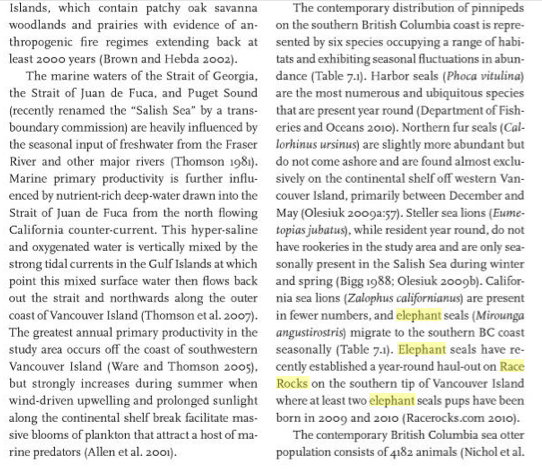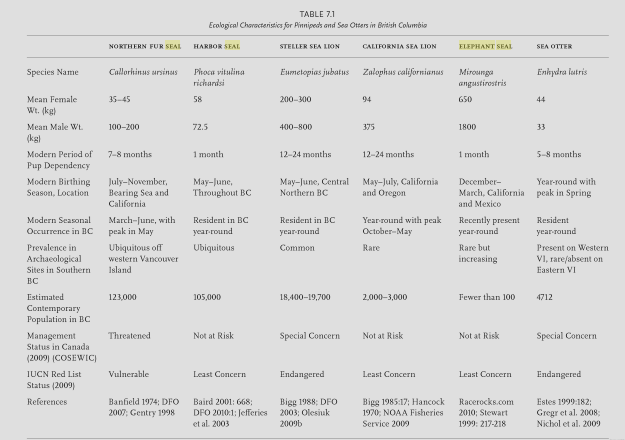 One chapter devoted to Elephant Seals mentions the breeding colony at Race Rocks:
One chapter devoted to Elephant Seals mentions the breeding colony at Race Rocks:
Daily Archives: Friday,July 15, 2011
illegal fishing
At around 1430hrs PDT a vessel was spotted fishing within the limits of the RCA. The vessel was reported to DFO and is described as an aluminum vessel, 3 persons on board, license number BC580071.
| Pleasure Boats: 1 | Eco-Tour: 15 | Total: 16 |
Race Rocks (XwaYeN) Proposed Marine Protected Area Ecosystem Overview and Assessment Report
Correct citation for this publication: Backe, N., S. Davies, K. Conley, G. Kosmider, G. Rasmussen, H. Ibey and K. Ladell.2011. Race rocks (XwaYeN) proposed marine protected area ecosystem overview and assessment report. Can. Manuscr. Rep. Fish. Aquat. Sci. 2949: ii + 30
Executive Summary
Background
Race Rocks (XwaYeN), located 17 km southwest of Victoria in the Strait of Juan de Fuca, consists of nine islets, including the large main island, Great Race. Named for its strong tidal currents and rocky reefs, the waters surrounding Race Rocks (XwaYeN) are a showcase for Pacific marine life. This marine life is the result of oceanographic conditions supplying the Race Rocks (XwaYeN) area with a generous stream of nutrients and high levels of dissolved oxygen. These factors contribute to the creation of an ecosystem of high biodiversity and biological productivity.In 1980, the province of British Columbia, under the authority of the provincial Ecological Reserves Act , established the Race Rocks Ecological Reserve. This provided protection of the terrestrial natural and cultural heritage values (nine islets) and of the ocean seabed (to the 20 fathoms/36.6 meter contour line). Ocean dumping, dredging and the extraction of non-renewable resources are not permitted within the boundaries of the Ecological Reserve. However, the Ecological Reserve cannot provide for the conservation and protection of the water column or for the living resources inhabiting the coastal waters surrounding Race Rocks (Xwa YeN) as these resources are under the jurisdiction of Fisheries and Oceans Canada (DFO). The federal government, through the authority of theOceans Act (1997), has established an Oceans Strategy, based on the principles of sustainable development, integrated management and the precautionary approach. Part II of the Oceans Act also provides authority for the development of tools nece ssary to carry out the Oceans Strategy, tools such as the establishment of Marine Protecte d Areas (MPA). This federal authority will complement the previously established protection to the area as an Ecological Reserve, by affording protection and conservation measures to the living marine resources. Under Section 35 of the Oceans Act, the Governor in Council is authorized to designate, by regulation, Marine Protected Areas (MPA) for any of the following reasons:
- (a) the conservation and protection of commercial and non-commercial fishery resources, including marine mammals and their habitats;
- (b) the conservation and protection of endangered or threatened species and their habitats;
- (c) the conservation and protection of unique habitats;
- (d) the conservation and protection of marine areas of high biodiversity or biological productivity; and
- (e) the conservation and protection of any other marine resource or habitat as is necessary to fulfill the mandate of the Minister of Fisheries and Oceans.
In 1998, the Minister of Fisheries and Oceans announced Race Rocks (XwaYeN) as one of four pilot Marine Protected Area (MPA) initiatives on Canada’s Pacific Coast. Race Rocks (XwaYeN) meets the criteria set out in paragraphs 35(1) (a), (b) and (d) above. Establishing a MPA within the Race Rocks (XwaYeN) area will provide for a more comprehensive level of conservation and protection for the ecosystem than can be achieved by an Ecological Reserve on its own. Designating a MPA within the area encompassing the Ecological Reserve will facilitate the integration of conservation, protection and management initiatives under the respective authorities of the two governments.
physical and biological systems of Race Rocks (XwaYeN) was completed by Wright and Pringle (2001). The 2001 report provides an extensive ecological overview describing the geological, physical oceanographic and biological components of
Race Rocks (XwaYeN) and the surrounding waters of the Strait of Juan de Fuca at the time. Natural history observations and some traditional knowledge were also included. The following report is a brief update to summarize new information that has been collected in the Race Rocks (XwaYeN) area since that time and describe any changes
to trends in species distributions and oceanographic conditions. This work is meant to supplement the existing ecological overview (Wright and Pringle 2001).
See the full 32 page PDF Ecosystem overview2011


